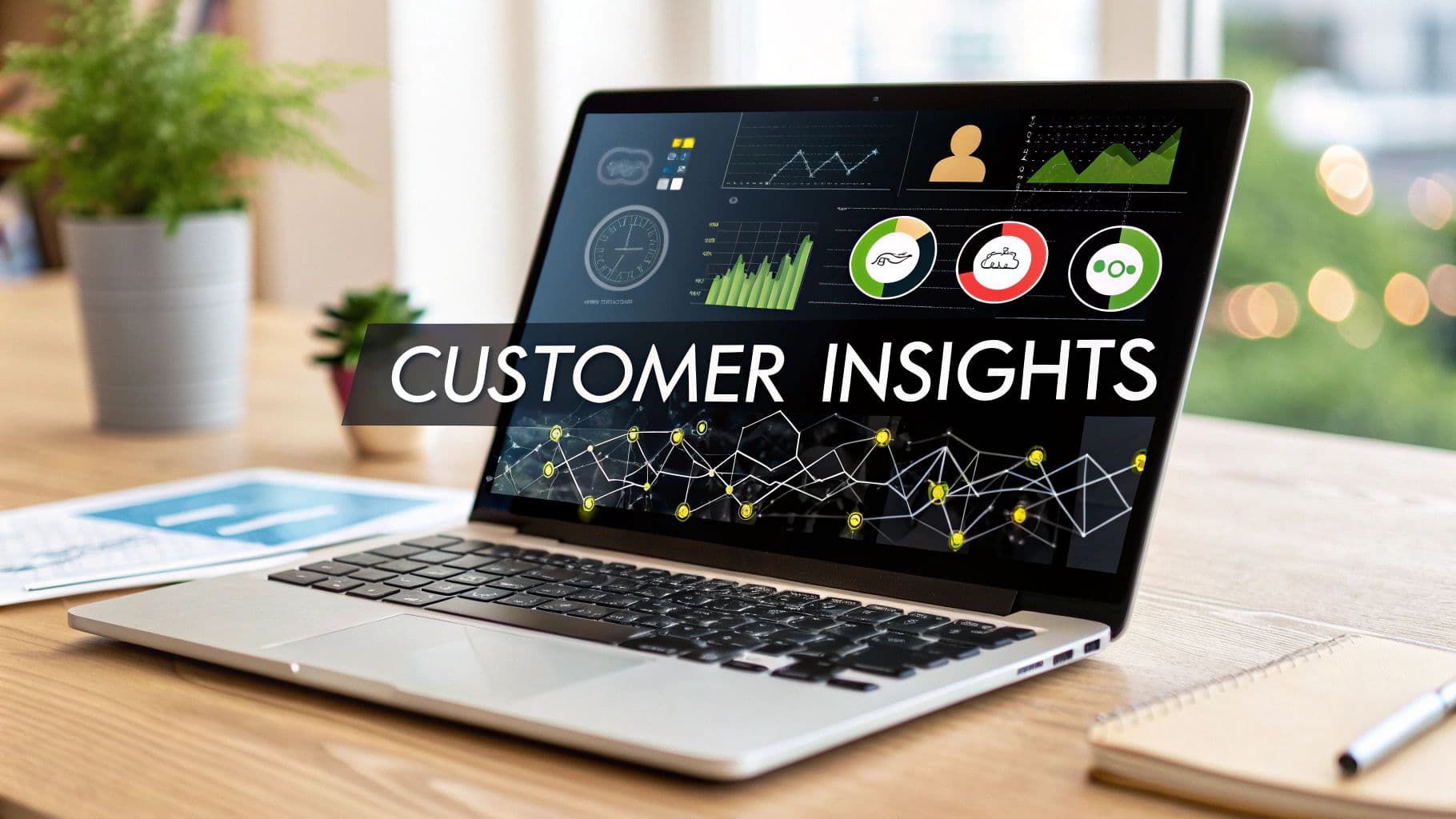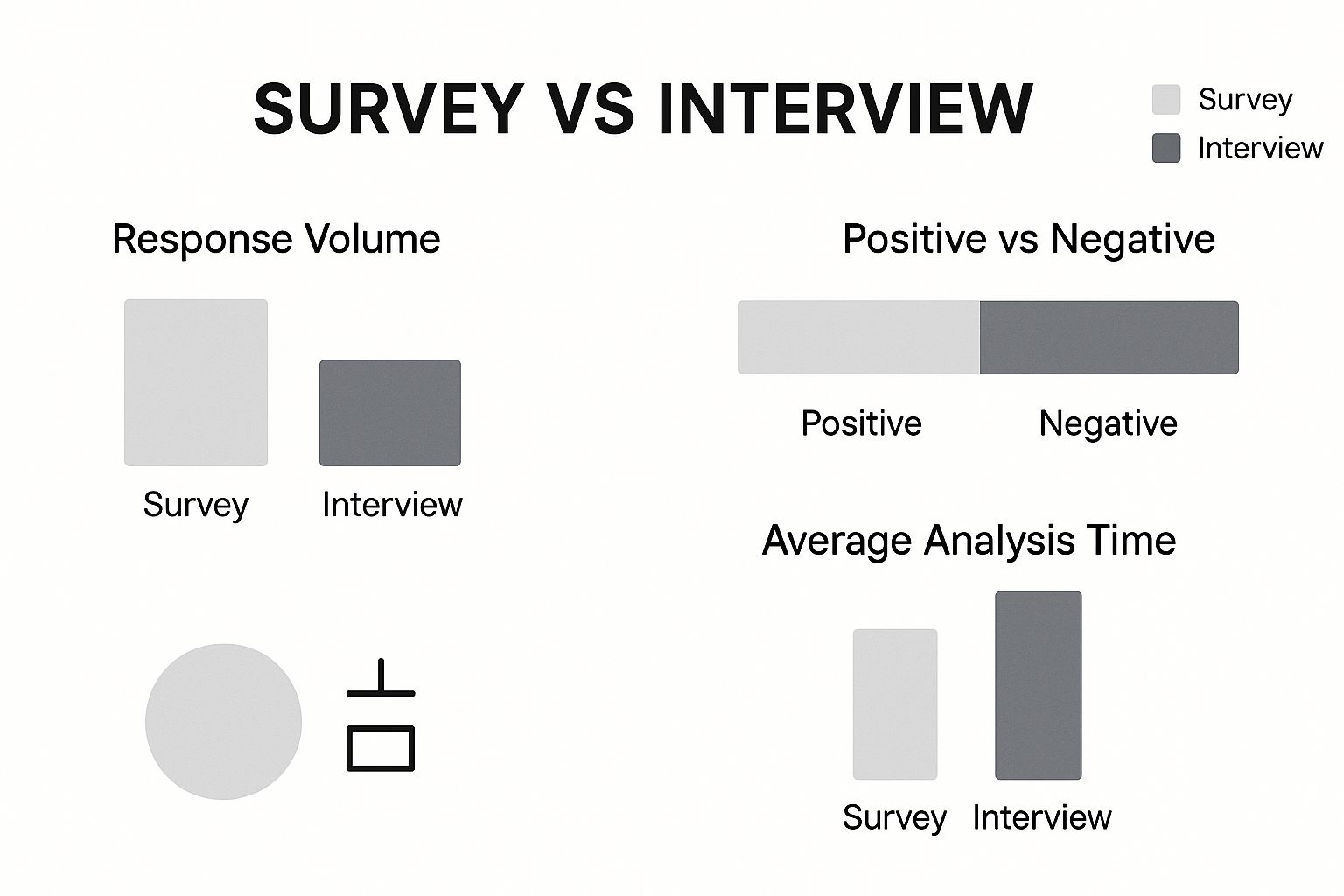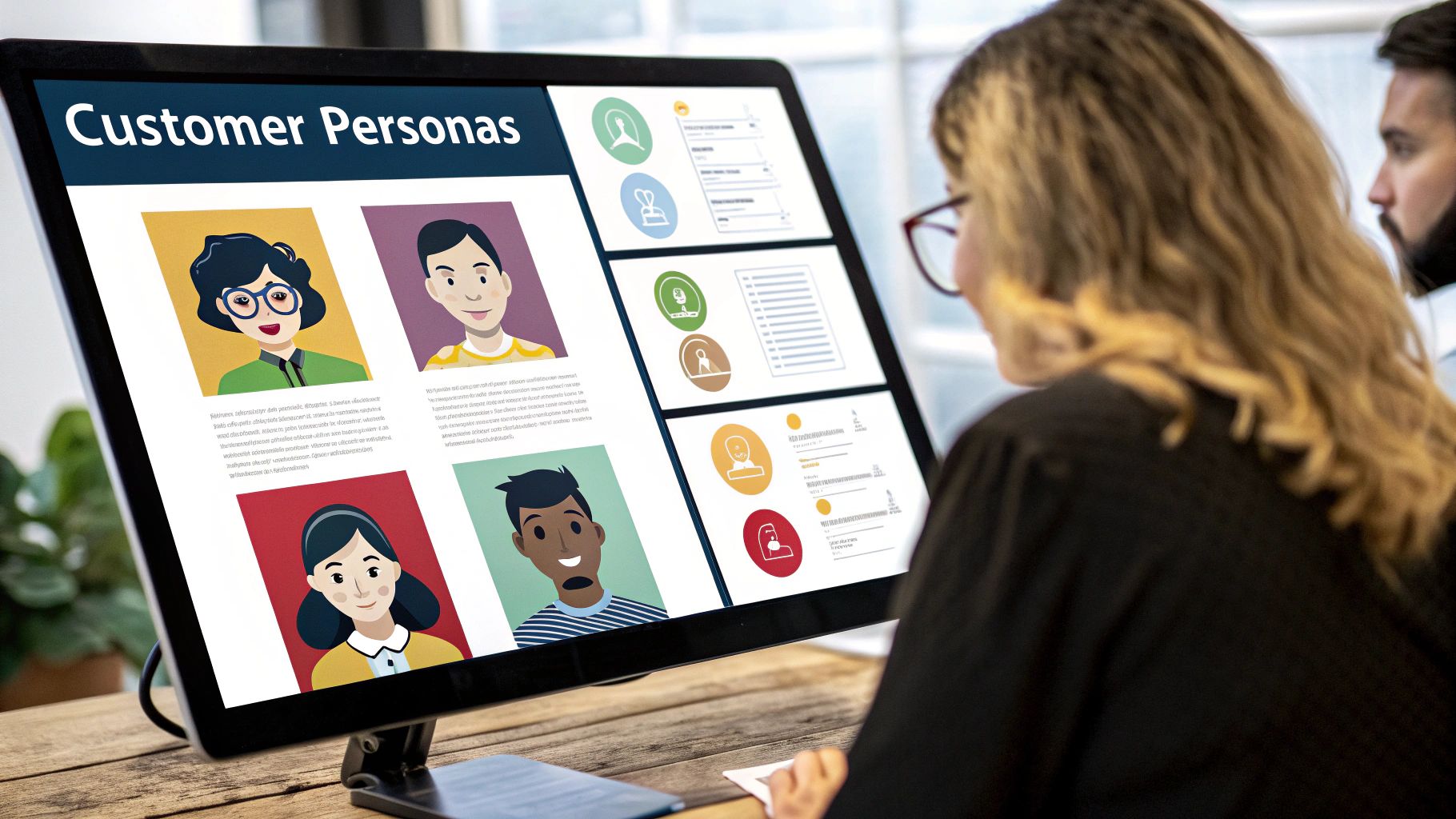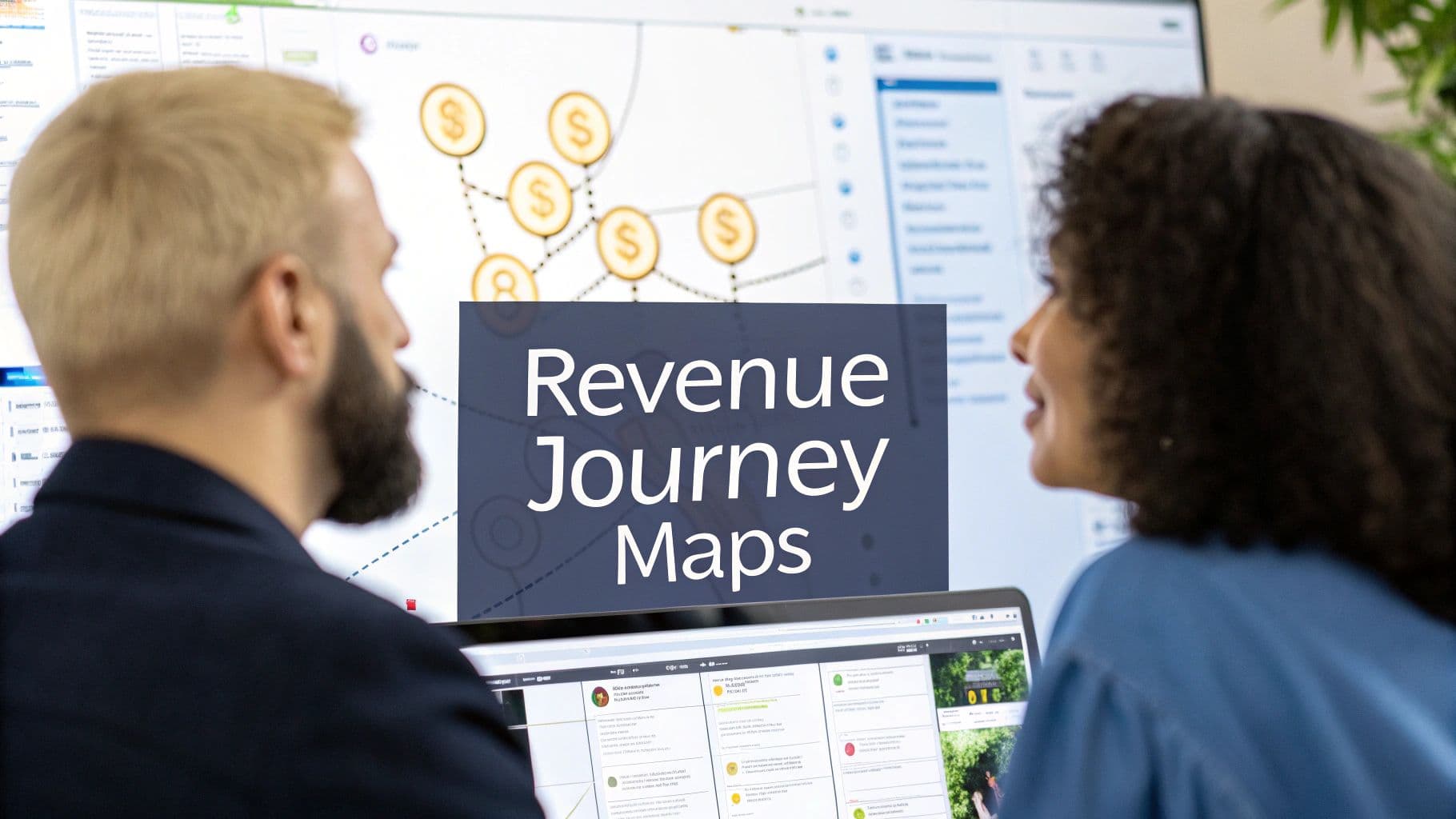How to Understand Customer Needs and Fuel Growth
Unlock business growth with our guide to understand customer needs. Learn key methods, frameworks, and AI-powered tactics for lasting customer loyalty.

If you really want to understand your customers, you have to stop thinking about selling them a product. Instead, focus on solving a problem for them. This means digging deeper than what they buy to uncover why they buy it. This single shift in perspective is the compass that guides every smart business decision.
Why Your Business Needs a Compass
At the core of any successful company is a relentless focus on its customers. Think of customer insights as your business's true north—a compass guiding everything from product development roadmaps to marketing campaigns.
Ignoring those signals is like sailing into a storm without a map. You're bound to miss opportunities, watch loyalty fade, and eventually, find yourself completely lost. A genuine commitment to understanding what your customers need is the bedrock of any business built to last.
This isn't just a feel-good philosophy; it's a critical business function. When you align your entire operation with what customers actually want, you create a powerful competitive edge. You start anticipating where the market is headed instead of just reacting to it.
The Foundation of Lasting Success
When you build your business on a solid foundation of customer understanding, you start seeing tangible results across the board.
- You build fierce customer loyalty. When people feel heard and understood, they stick around. A loyal customer base isn't just a stable source of revenue; they become your most passionate brand advocates.
- You develop smarter products. Direct user insights take the guesswork out of the equation. You stop building features you think people want and start delivering solutions you know they need. This saves an incredible amount of time and money while getting you to product-market fit faster.
- Your marketing actually works. Knowing your customers' true pain points and motivations lets you craft messages that connect on a personal level. This naturally leads to better conversion rates and a much higher return on your marketing spend.
But there's a big difference between knowing this is important and actually doing it well. The quality of a company's customer experience (CX) is a direct reflection of how well it understands and meets these needs.
Recent data shows a pretty worrying trend: CX ratings are dropping globally. In the U.S. alone, 25% of brands saw their customer experience rankings drop for the second year in a row, while only 7% managed to improve. This tells us that many companies are struggling to deliver value that customers feel is worth their time and money. You can explore more of these customer experience findings on Forrester.com.
A deep understanding of customer needs isn't a one-off project; it’s a commitment. The table below breaks down the real-world outcomes of getting this right—and the costs of getting it wrong.
| Business Area | Impact of Understanding Needs | Consequence of Neglecting Needs |
|---|---|---|
| Product Development | Products solve real problems, leading to high adoption and market fit. | Features are built on assumptions, resulting in wasted resources and low usage. |
| Marketing & Sales | Campaigns resonate deeply, driving higher conversion and brand loyalty. | Messages fall flat, leading to low engagement and wasted ad spend. |
| Customer Service | Support is proactive and effective, increasing satisfaction and retention. | Teams are reactive and overwhelmed, causing high churn and brand damage. |
| Overall Strategy | The business innovates and anticipates market shifts with confidence. | The company is always playing catch-up, vulnerable to competitors. |
Ultimately, the goal is to weave this customer-centric mindset into your company’s DNA. Today, modern technology—especially AI—is opening up incredible new ways for businesses to listen, interpret, and act on what their customers are telling them. In the sections that follow, we’ll dive into both the timeless methods and the advanced strategies you can use to master this crucial skill.
Mastering the Classic Ways to Gather Customer Insights

Before we jump into the high-tech world of AI and analytics, it's crucial to get the fundamentals right. For decades, smart businesses have relied on a core set of methods to understand customer needs: surveys, interviews, and focus groups. These aren't just old-school tactics; they are the bedrock of customer research, giving you the direct, human context that raw data can never provide.
Think of it like this: a survey gives you a bird's-eye view of your customer landscape, an interview is a deep-dive conversation with one person, and a focus group lets you listen in on how a community thinks and interacts. Each lens offers a unique perspective. When you put them together, you get a rich, three-dimensional picture of what your customers are really after.
These methods are about more than just asking questions. They’re about starting real conversations to uncover what drives people, what frustrates them, and what they aspire to. Mastering these is the first step toward building a business that people genuinely love.
Designing Surveys That Actually Get You Answers
Surveys are fantastic for gathering a ton of information from a broad audience, fast. They can help you check your assumptions and get a pulse on how customers feel at scale. But here’s the catch: a badly designed survey is worse than no survey at all. It can give you messy data and lead you down the wrong path.
The absolute key is to eliminate bias. Leading questions, confusing options, or making it a marathon to complete will just annoy people and taint your results. Your goal is to make it as easy as possible for customers to share their honest, unfiltered thoughts.
Here are a few quick tips to get it right:
- One idea per question: Keep it simple. Don’t try to cram multiple topics into a single question.
- Stay neutral: Frame your questions so they don't hint at a “right” answer. Instead of, “How much did you love our amazing new feature?” ask, “How would you rate your experience with our new feature?”
- Mix it up: Use a blend of multiple-choice, rating scales, and open-ended questions. This gives you hard numbers and the stories behind them.
Running Interviews That Uncover the "Why"
While surveys tell you what people are doing, one-on-one interviews are where you discover why. These deep conversations are unmatched for exploring complex behaviors and getting at the real emotional drivers behind a customer's choices. Sometimes, an interview can reveal an insight the customer didn't even know they had.
The secret to a great interview is making it feel like a relaxed chat, not an interrogation. You’re there to listen, not to lead. Start with big, open-ended questions and then gently dig deeper based on what they say. Your most powerful tool is your own curiosity.
A classic example is how Procter & Gamble came up with the Swiffer. By visiting people’s homes and just talking to them, they learned that mopping wasn't just a hassle—it was the gold standard for a deep clean. That insight was a game-changer. It meant the Swiffer couldn’t just be easier; it had to be better. And that’s what made it a massive success.
Facilitating Focus Groups That Spark Ideas
Focus groups bring a small, diverse set of customers together for a guided discussion. They are incredibly valuable for testing new ideas, getting feedback on marketing messages, or understanding how social dynamics influence opinions. The real magic happens when participants start riffing off each other's comments, sparking debates and new ideas you’d never get otherwise.
Having a skilled moderator is non-negotiable. Their job is to steer the conversation without controlling it, making sure everyone gets a voice while keeping the discussion focused. The goal is to create a space where people feel safe to share their honest opinions, even if they disagree with the group.
Of course, these traditional methods have their limits. They take time, they're hard to scale, and they can be prone to human bias. Sifting through hours of interview recordings or hundreds of open-ended survey answers is a serious grind. This is exactly where technology comes in, giving us the power to amplify these timeless techniques and uncover insights at a speed and scale we could only dream of before.
Think of raw customer data as a giant pile of puzzle pieces. You know there’s a picture in there somewhere, but without the box lid to guide you, it’s just a chaotic mess. To truly understand customer needs, you need frameworks—structured approaches that turn scattered insights into an actionable roadmap.
These frameworks provide the "box lid," helping you organize feedback, visualize the customer experience, and pinpoint exactly where you should focus your efforts. They transform abstract data into a clear story about your customer's life, showing you not just what they do, but why they do it. This clarity is the first step toward building products and services that solve real problems.
The Jobs to be Done Framework
One of the most powerful mindset shifts you can make is adopting the Jobs-to-be-Done (JTBD) framework. The core idea is simple yet profound: customers don't buy products; they "hire" them to do a specific "job." This job is simply the progress they are trying to make in a particular situation.
The classic example involves a fast-food chain trying to sell more milkshakes. They surveyed customers, asking about flavor, thickness, and price, but none of their changes moved the needle. Frustrated, they tried a different approach. Researchers spent a day just observing who was buying milkshakes and why.
They discovered something surprising. A huge portion of milkshakes were sold before 9 AM to solo commuters. The milkshake's "job" wasn't to be a sweet treat; it was to be an easy, clean, and engaging companion for a long, boring drive to work.
Understanding this "job" allowed the company to optimize the milkshake for its actual purpose. They made it thicker so it would last longer and added tiny fruit pieces to make it more interesting to drink. Sales soared because they finally understood the real need.
Mapping the Entire Customer Journey
While JTBD helps you understand the underlying motivation, a Customer Journey Map helps you visualize every single interaction a person has with your company. It’s a chronological story of their experience, from the moment they realize they have a problem to the point where they become a loyal advocate for your brand.
Mapping this journey is like watching a film of your customer's experience, letting you see the highs and lows from their perspective. It uncovers hidden friction points and moments of unexpected delight you would otherwise miss completely.
Creating a useful journey map involves a few key steps:
- Define the Scope: Start by focusing on a specific customer persona and a particular goal they are trying to achieve, like signing up for a trial or resolving a support issue.
- Identify Touchpoints: List every point of interaction the customer has. This includes your website, social media ads, sales calls, onboarding emails, and support chats.
- Map Actions and Emotions: For each touchpoint, document what the customer is doing, thinking, and feeling. Are they frustrated by a confusing checkout process? Delighted by a quick support response?
- Pinpoint Pain Points and Opportunities: The final step is analysis. Where are customers struggling? Where are things going smoothly? Each pain point is an opportunity to improve, and each high point is something to double down on.
For example, a SaaS company might discover through journey mapping that customers are excited during the sales process but become confused and anxious during product setup. Their emotional journey takes a nosedive right at the beginning. This insight is pure gold.
It tells the product team exactly where to focus their energy: not on adding new features, but on creating a smoother, more guided onboarding experience. This single change, discovered through mapping, could dramatically reduce churn and increase customer satisfaction.
By combining the "why" from Jobs-to-be-Done with the "what, where, and when" from Customer Journey Mapping, you move from simply collecting feedback to strategically understanding it. These frameworks provide the structure needed to connect your business actions directly to the real, human needs of your customers, ensuring you’re not just building things right, but building the right things.
Using AI to Decode Customer Needs at Scale
Traditional research methods are a great starting point, but let’s be honest—they have their limits. Manually sifting through thousands of survey responses, interview notes, or focus group recordings is a massive undertaking. It's slow, expensive, and inevitably colored by human bias.
This is where AI comes in. It’s not here to replace human expertise, but to supercharge it. Think of AI as the world’s most efficient analyst, one that can process huge amounts of unstructured data—social media chatter, product reviews, support emails, sales calls—without ever needing a coffee break. It spots patterns that are practically invisible to the human eye, helping you move from slow, quarterly feedback cycles to a constant flow of real-time insights.
The difference in scale is staggering. The sheer volume of digital feedback available today completely dwarfs what traditional methods can ever hope to capture.

As you can see, keeping up with the speed and volume of modern customer feedback requires a more automated, intelligent approach.
Uncovering Emotion with Sentiment Analysis
One of the most immediate ways AI can help is through sentiment analysis. You can think of it as taking the emotional temperature of your entire customer base. This technology scans text-based feedback and instantly gauges the feeling behind the words—positive, negative, or neutral. Instead of spending weeks reading 10,000 product reviews, an AI can give you the big picture in minutes.
But it’s much more sophisticated than a simple thumbs-up or thumbs-down. Modern AI can pick up on subtle nuances like frustration, delight, or confusion. For example, a customer might say, "The new update looks great, but I can't find the export button anywhere." A smart system flags this as mixed sentiment, noting the praise for the design while also highlighting the usability issue.
At SigOS, we use this to automatically categorize support tickets as they come in. If a customer's frustration levels are spiking, the ticket gets flagged and prioritized. This lets our support team jump on critical issues and reach out to at-risk customers before they decide to leave.
Identifying Key Themes with Topic Modeling
While sentiment tells you how customers feel, topic modeling tells you what they’re talking about. This AI technique automatically scans massive amounts of text and groups related conversations into distinct themes or "topics." It's like having an assistant who reads every single piece of feedback and organizes it into neat, labeled piles for you.
Imagine you've just launched a new feature. An AI could chew through thousands of support tickets and tell you that the top three emerging topics are "login issues," "confusing UI," and "integration problems." Suddenly, your product team has a data-backed roadmap handed to them on a silver platter. You can see more practical applications in our guide on AI for product management.
This is a huge step up from manual tagging. It strips out bias and often uncovers "unknown unknowns"—those brewing problems or feature ideas you didn't even know were on your customers' minds.
AI-powered techniques simply operate on a different level than traditional methods. They allow you to get deeper insights from more data, faster than ever before.
AI-Powered Techniques vs Traditional Methods
| Capability | Traditional Methods (e.g., Surveys) | AI-Powered Analysis |
|---|---|---|
| Scale | Limited to a few hundred or thousand responses. | Can analyze millions of data points from diverse sources. |
| Speed | Analysis can take weeks or months. | Provides insights in near real-time. |
| Depth | Relies on pre-set questions; may miss nuances. | Uncovers hidden themes, sentiment, and context from open-ended text. |
| Bias | Prone to human interpretation and researcher bias. | Objective, pattern-based analysis reduces human bias. |
| Cost | High manual labor costs for data collection and analysis. | Lower long-term cost through automation. |
Ultimately, AI empowers teams to build a continuous, dynamic understanding of the customer that simply isn’t feasible through manual effort alone.
Forecasting the Future with Predictive Analytics
The real endgame isn't just understanding what customers need today, but anticipating what they'll need tomorrow. This is where predictive analytics comes into play. By analyzing historical data, machine learning models can forecast future outcomes, like identifying customers who are about to churn or spotting the next big market trend.
For instance, an AI might find that customers who run into a specific sequence of three minor bugs are 87% more likely to cancel their subscription within 30 days. Armed with that knowledge, your customer success team can step in with targeted help long before that customer even thinks about leaving.
This proactive approach is what sets market leaders apart. We know that 64% of consumers prefer companies that offer personalized experiences. At the same time, 53% of customers are concerned about how their data is used, which makes transparency and trust non-negotiable. AI-driven insights help you walk that line, delivering truly relevant solutions without crossing personal boundaries.
By weaving these AI techniques together, businesses can create a living, 360-degree view of their customers. You can finally stop reacting to yesterday's feedback and start proactively building the experiences your customers will love tomorrow.
Turning Customer Insights Into Winning Strategies

Collecting customer data is one thing, but actually using it to build a real competitive edge is a whole different ballgame. Insights are just interesting facts until you act on them. This is the moment where you close the loop—connecting what your customers want with what you deliver, creating a straight line from feedback to business growth.
To really understand customer needs and bake them into your strategy, you need a playbook. This isn't about throwing ideas at the wall and seeing what sticks. It's about building a repeatable process that links what you've learned directly to improvements in your product, marketing, and service.
From Data Points to Strategic Pillars
The first move is to group all your raw insights into major themes. Once you’ve sifted through surveys, interviews, and AI-powered analysis, you'll start to see clear patterns bubbling to the surface. These themes are the foundation of your new strategy, telling you exactly where to focus your time, money, and energy.
Instead of staring at a messy list of feature requests and complaints, you can define broad strategic pillars. Think of it like this:
- Improve the Onboarding Experience: If data from multiple channels shows new users are getting stuck in their first week, this becomes a huge priority.
- Simplify the Core Workflow: Maybe feedback reveals that your best features are just too hard to find or use. That’s a clear signal to streamline things.
- Strengthen Post-Purchase Support: A flood of support tickets about shipping or product setup tells you that you need better communication after the sale is made.
Framing your insights this way turns chaotic data into a focused plan, giving your teams clear, meaningful goals to rally behind.
Case Study: A Retailer Listens to Local Needs
Picture a national retail brand that saw sales flagging in certain regions. Instead of launching a generic, one-size-fits-all marketing campaign, they dug into local feedback. What they found was a powerful, growing preference for locally sourced products—a trend their centralized supply chain was completely missing.
This insight became a new strategic pillar: "Prioritize local relevance." The company reworked its logistics to stock goods from regional artisans and launched marketing campaigns that celebrated their connection to the local community. The payoff? A major lift in both sales and brand loyalty in those areas.
This lines up perfectly with a broader market shift. Recent studies show 47% of global consumers feel it's important to buy from locally owned businesses, believing they simply fit their specific needs better. By actually listening, this retailer turned a weak spot into a massive win. You can dig deeper into consumer trends toward local brands from McKinsey.
Case Study: A SaaS Company Redefines Its Roadmap
Now let's look at a B2B SaaS company that was bleeding customers. Their product team was cranking out impressive new features, but churn just kept climbing. It wasn't until they used a platform like SigOS to analyze thousands of support tickets and sales call transcripts that they had their "aha" moment.
The number one frustration wasn't a lack of features. It was the unreliability of a few core functions. The AI analysis clearly showed that support tickets mentioning "bugs" and "slow performance" were almost always linked to accounts that eventually cancelled their subscriptions.
This data triggered a complete strategic pivot. The company hit pause on all new feature development for an entire quarter. Instead, they dedicated the whole engineering team to a single "Stability and Performance" initiative. They squashed bugs, slashed loading times, and fortified their infrastructure.
The impact was huge. Within six months, customer churn dropped by 18%, and satisfaction scores went through the roof. This data-driven shift from "more features" to "a better experience" was fundamental to their long-term success and is a great example of protecting customer lifetime value. You can learn more by reading our guide on how to calculate customer lifetime value. It ultimately saved them from losing their most important customers.
Building a Culture of Customer-Centricity
We've covered everything from classic interviews to sophisticated AI analysis. But none of it matters if the insights just sit in a report. The final, most crucial step is to weave this knowledge into the very fabric of your company.
Truly great companies get this. They know that to understand customer needs isn’t a one-off project or a task for a single department. It’s a relentless, company-wide obsession.
This means building a culture where everyone, from the newest developer to the head of marketing, feels connected to the customer's world. It's about creating systems and workflows that make customer feedback impossible to ignore. When insights are shared openly and acted upon, teams just start making better decisions on their own.
Think of it as shifting from occasional check-ins to a constant, flowing conversation. You're aiming for a living feedback loop where the customer's voice directly shapes every strategic move you make.
The Human and Technology Partnership
The future here isn’t about choosing between human empathy and the raw power of technology. The real winners will be the companies that masterfully blend both. It’s a beautiful partnership: human curiosity asks the smart, insightful questions, and AI delivers the answers at a scale and speed we couldn't have dreamed of a decade ago.
Here's how that synergy plays out:
- Empathy sets the direction: Your team’s intuition, born from direct customer conversations, uncovers the subtle "why" behind what people do.
- Technology provides the proof: AI and data analytics then validate those gut feelings with cold, hard evidence across your entire user base.
This creates a powerful, self-improving cycle. A human observation sparks a hypothesis, AI tests it against millions of data points, and the findings guide the next wave of empathetic conversations. This dual approach ensures you’re not just data-driven, but truly insight-led.
Building a customer-centric culture means empowering your team with both the tools to listen and the autonomy to act on what they hear. It’s a commitment to making customer obsession your default setting.
From Insights to Sustainable Growth
At the end of the day, making customer understanding a core part of your culture is the only way to build a business that lasts. Markets will change, new competitors will pop up, but a deep, genuine connection with your customers acts as your constant North Star.
It ensures your business doesn't just survive, but actually thrives by evolving right alongside the people you serve.
This ongoing process is fundamental to long-term success. As you keep listening and learning, you'll naturally uncover fresh opportunities for innovation and new ways to deliver value. This is a central theme in effective marketplace growth strategies, where staying one step ahead of customer expectations is the name of the game.
By making customer-centricity a core operational principle, you turn your entire organization into a powerful engine for sustainable growth, always ready to meet the needs of tomorrow.
A Few Common Questions, Answered
As you dive deeper into understanding your customers, a few questions always seem to pop up. Let's tackle some of the most common ones I hear from teams just getting started.
How Often Should We Be Gathering Feedback?
Honestly, the best cadence is continuous. Think of it less like a scheduled event (like a quarterly survey) and more like an always-on listening post.
Of course, big moments like a major product launch or a pivot in strategy are perfect times for a deep dive into feedback. But the real magic happens when you’re constantly tuning into the background chatter from support tickets, online reviews, and social media. That’s where you’ll find the real-time pulse of your customers.
We're a Small Business. What's the Best First Step?
If you're just starting out, don't get bogged down with fancy tools. Just start talking to people. Seriously.
Your first move should be to line up five to ten casual conversations with recent customers. Ask them open-ended questions about why they bought your product and what problem they were trying to solve. This kind of direct, human feedback is pure gold for building a foundation of real empathy.
How Can I Actually Prove the ROI of This Work?
This is a big one. The key to proving the return on investment (ROI) is to draw a straight line from a customer insight to a business metric.
Track how a specific change, prompted by feedback, moved a number that matters. For instance, you could show how simplifying a clunky checkout flow—a common complaint you uncovered—led to a 15% drop in cart abandonment. Or how fixing a persistent bug you learned about from support tickets cut customer churn by 5%.
What Are the Big Mistakes I Should Avoid?
The biggest pitfall is confirmation bias—where you're only looking for feedback that confirms what you already believe. It's a natural human tendency, but you have to fight it.
Another common mistake is taking feature requests at face value. When a customer says they want a "blue button," don't just add it to the list. Dig deeper to understand why they want it. Maybe the real problem is that "the current button is hard to see." Always separate what you observe from how you interpret it.
Ready to turn all that customer feedback into a clear roadmap? SigOS uses AI to sift through your qualitative data and pinpoint the insights that will actually drive revenue. We help you focus on what truly matters to your customers.


